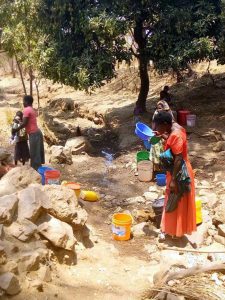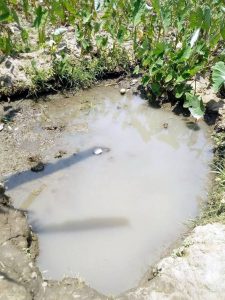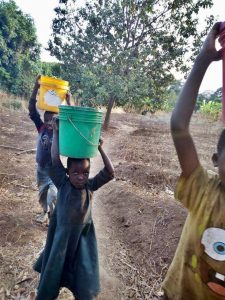This project is made possible through the partnership of WATER CHARITY and the NATIONAL PEACE CORPS ASSOCIATION. ![]()
 Location
Location
This project summary has been redacted for security reasons to omit the specific project location.
Xxxxxxxx, Mbeya district, Mbeya, Tanzania
Community Description
The community of Xxxxxxxx is located in the region of Mbeya. The population is 1,500 people, 740 females and 760 males. A high percentage of this population is composed of children; HIV and other illnesses have had devastating effects, leaving 200 orphans to be cared for by another family. A staggering 25% of the population is under 18.
The Xxxxxxxx clinic is responsible for the care of the 1,500 community members as well as surrounding communities. In total, the Xxxxxxxx clinic serves over 4,000 people and the school’s 250 students.
The community members, despite their issues, are always kind and welcoming to all people, and it is a very peaceful environment. There is little to no crime in the community. The community consists of hard workers: farmers and pastoralists who sell their goods in a nearby town. They always love to talk to people about where they are from, teach them tribal greetings, and overall just sit down and have a good laugh.
Problem Addressed
Xxxxxxxx is a poor community where easy access to clean water is a serious problem. It is also a particular issue for the health clinic and school as the closest water source, a river, is about a 5-km walk. This hurts the already vulnerable young and sick community members.
During the dry season, these already small rivers become more scarce and farther away. Many villagers having to walk an hour or more to the river in the village over. The path conditions to the water are also dangerous and dirty, often on a road with speeding buses, cars, and motorcycles that cover the people they pass in dirt or mud. This dirt has been getting into the lounges of the children causing high respiratory infections in the village.
Besides the issue of distance, this water is highly contaminated as it has run through the mountains, farmland with manure and pesticides, as well as living quarters, adding human contamination.
Community members suffer from various illnesses, caused or worsened by the lack of sanitary water, making it a struggle to recover and stay healthy. For example, one community member recently died due to dehydration while working in his field. Approximately 100 children a year are treated for dehydration due to diarrhea; half of those are school-age children who miss school, hurting their education and health. Cases of typhoid and cholera have also been reported in the village due to unsanitary conditions of the water.
Due to scarcity of water, washing hands is rarely practiced, leading to increased illness in the village. The village health clinic and the school also do not have access to clean drinking water or cleaning water.
Young students are often tasked with the chore of fetching water, distracting them from schoolwork and hurting their ability to succeed. The only investment in a water system has been private, for use as farmland irrigation.
Project Description
This project is to build a piping system to provide safe water for the clinic, the school, and the community at large.
Uncontaminated water will be piped from a spring at the top of the mountain (750 meters above the community) to the health clinic, school, and community office. The PVC piping will be 2 ½ inches in diameter and will run 2,011 meters down the rugged terrain of the mountainside. The piping will be buried in some tougher areas by the community members, but in most areas, it will be weighed down using buried cement blocks created by a local carpenter.
It will take an estimated two weeks to complete all the installation of the pipes. Some committee members will be present while the work is being done in order to ensure quality and to answer any questions by the contractor. The project committee will be responsible for purchasing of the pipes, stands, faucets, cement, and connectors, and delivery to the contractor.
Once the installation is complete, the project committee will hold a community meeting with the nurse to teach people about the sanitation of the water, and good hygiene practices now that water is more accessible.
Water Charity funding will be used for materials and skilled labor. The community will pay for the transport of materials, local materials, and unskilled labor.
The work will be coordinated by the project committee, which includes town leader Paulo JoJo, Peirs Masalamwez, Anastazia Daniel, Yassin Ibilahim, Teacher Issa Hassan, Jerimiah Francis, Suzani Shanbo, Jane Julius, Lidia Edson, and the PCV.
 Project Impact
Project Impact
4,000 people will benefit from the project
Peace Corps Volunteer Directing Project
E. Anthony
Monitoring and Maintenance
The contractor lives in the village and will inspect the installation monthly. If anything unexpected happens, he will be able to help without having to wait for an outside contractor. This contractor has past experience with installing piping systems from the top of the mountain and knows how to fix issues with the PCV piping, such as holes, connection problems, or animal interference.
The clinic’s records from the previous years will be used to measure changes in water-related health issues; these records show age, gender, issue, and time of visit. School records will be used to compare student absences and performance in previous years with those after the completion of the project.
Comments
This project will decrease the incidence of illness due to a lack of clean water. This will decrease the amount of time missed from school due to diarrhea, improve daily hydration, and decrease the amount of time missed from school due to fetching water.
This project has been funded by an anonymous donor. Please donate to our East Africa Water & Sanitation Program.